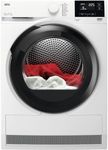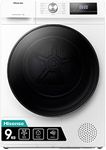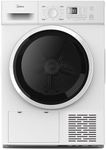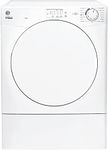Buying Guide for the Best Tumble Dryers
Choosing the right tumble dryer can make a significant difference in your laundry routine, saving you time and energy. When selecting a tumble dryer, consider the size of your household, the types of fabrics you frequently dry, and the space available for the appliance. Understanding the key specifications will help you make an informed decision that best suits your needs.CapacityCapacity refers to the amount of laundry a tumble dryer can handle in one cycle, usually measured in kilograms. This is important because it determines how much laundry you can dry at once, affecting both convenience and energy efficiency. Smaller households or those with limited space might opt for a dryer with a capacity of 6-7 kg, which is suitable for light loads. Medium-sized families might find a 7-9 kg capacity more appropriate, while larger households or those who frequently wash bulky items like duvets should consider a dryer with a capacity of 9 kg or more. Choose a capacity that matches your typical laundry load to avoid overloading or underutilizing the dryer.
Energy EfficiencyEnergy efficiency indicates how much electricity a tumble dryer uses to dry clothes, typically rated from A+++ (most efficient) to D (least efficient). This is crucial for both environmental impact and your electricity bills. More efficient models, such as those rated A+++, use less energy and are better for the environment, but they may have a higher upfront cost. If you use your dryer frequently, investing in a more efficient model can lead to significant savings over time. Consider your usage patterns and prioritize energy efficiency if you want to reduce your carbon footprint and save on energy costs.
Type of DryerThere are three main types of tumble dryers: vented, condenser, and heat pump. Vented dryers expel moist air through a hose, requiring a window or vent, making them less suitable for apartments. Condenser dryers collect moisture in a tank, which needs regular emptying, offering more flexibility in placement. Heat pump dryers are the most energy-efficient, using lower temperatures to dry clothes, which is gentler on fabrics. They are ideal for those who prioritize energy savings and fabric care. Choose a type based on your living situation, energy preferences, and fabric care needs.
Drying ProgramsDrying programs are preset settings that adjust the drying time and temperature for different types of fabrics and loads. This feature is important for ensuring that your clothes are dried efficiently and without damage. Basic models may offer a few standard programs, while more advanced models provide a wide range of options, including settings for delicates, wool, and quick-dry cycles. Consider the types of fabrics you frequently dry and choose a dryer with programs that match your needs. If you have a variety of fabrics, a model with more program options can offer greater flexibility and care.
Noise LevelNoise level, measured in decibels (dB), indicates how loud a tumble dryer is during operation. This is particularly important if your dryer is located in a living area or if you have an open-plan home. Quieter models, typically below 65 dB, are less disruptive and more suitable for such environments. If noise is a concern, look for models specifically designed to operate quietly. Consider where you will place the dryer and how much noise you are willing to tolerate during its operation.
Sensor DryingSensor drying technology uses sensors to detect the moisture level in the drum and automatically adjust the drying time. This feature is important for preventing over-drying, which can damage clothes and waste energy. It ensures that clothes are dried to the desired level of dryness, whether that's iron-dry or cupboard-dry. If you want to save energy and protect your clothes, look for a model with sensor drying. This feature is particularly useful for those who want to set and forget, as it provides peace of mind that the dryer will stop when the clothes are perfectly dry.
















